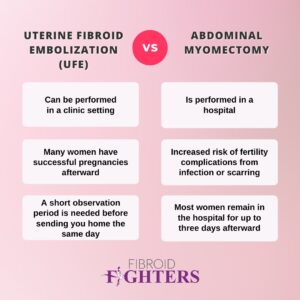If you have uterine fibroids, it's important to know your fibroid treatment options. Until recently, most women didn't hear about choices. Instead, they were given hysterectomies or other surgeries to treat fibroids and other causes of pelvic pain. But at least 80% of women with fibroids want to avoid removing their uterus. And we know there are better alternatives to a hysterectomy. Which is why we want women to know all their fibroid treatment options.

Sometimes, you don’t need to treat your fibroids. Instead, you can manage any symptoms that come up. If you have bad cramps or pelvic pain, you can use hot water bottles. In some cases, medications such as ibuprofen can help relieve your fibroid pain. And many women find symptom relief with yoga, regular exercise and even massage.
When you use this option, you may also try some natural fibroid treatments at home. First, you may try losing weight, since this study suggests that carrying extra weight ups your fibroid risk due to estrogen levels in fat cells. Also, managing your high blood pressure could reduce your fibroid symptoms. (This study suggests a link between fibroid symptoms and high blood pressure.)
Some women find taking hormonal birth control helps relieve their fibroid symptoms. But some forms of birth control can make fibroids grow larger. So talk to your doctor before choosing birth control with fibroids. For some women, an IUD may be a better way to manage symptoms such as heavy bleeding or painful cramps.
Recently, medications such as relugolix have been approved for treating heavy bleeding associated with uterine fibroids. And, results from the 3 LIBERTY study, published in the American Journal of Obstetrics & Gynecology, revealed that after two years of combination relugolix therapy, almost 70% of women maintained normal menstrual flow. (Defined as less than 80ml of blood loss.) However, a recent study in BMC Women's Health revealed a risk associated with this medication. Women with submucosal fibroids that also have a stalk may actually experience heavier bleeding if they take this medication. As such, it's important to know the location, size and shape of your fibroids before starting a relugolix prescription.
Another medication option is to take a GnRH agonist such as Lupron. This class of medication can temporarily shrink fibroids, also putting a stop to heavy bleeding. they work because they make your body stop producing estrogen. Unfortunately, they can also trigger symptoms of menopause and, if used for too long, they can lead to bone loss. As such, this treatment option is usually reserved for short-term uses to shrink fibroids prior to a surgical procedure such as myomectomy. (See below for more info.)
This procedure destroys your uterine lining. It doesn’t treat your fibroids directly, but it does cut down on heavy bleeding.
These treatment options only manage fibroid symptoms. But, if you want to get rid of your tumors, these fibroid treatment options will work better.
This minimally invasive treatment shrinks fibroids by cutting off their blood supply. It’s the procedure our Houston fibroid specialists deliver. So we’ll discuss it in greater detail below.
This surgery removes your individual fibroids. It’s a great option if you want to have a family, since it won’t impact your fertility in any way. (You just have to wait up to 6 months after your surgery before getting pregnant.) Still, your fibroids may come back, so this isn’t a permanent fibroid treatment option.
Also, there are different kinds of myomectomies, each of which could impact your health differently. Your doctor should perform a preoperative MRI to tailor your surgery to the size, number and location of your fibroids. Because, if you have large or numerous fibroids, you'll probably be offered an open or abdominal laparotamy. With this procedure (which requires about 3 days in hospital) your surgeon makes a small incision and removes your fibroids whole. It is a complicated procedure, so you should only work with a surgeon who's very experienced in this area.
For smaller or fewer fibroids, the doctor may perform a mini-laparotomy, which swaps a small abdomen opening for a the larger incision of the open procedure. In some cases, you can have a laparoscopic procedure, which allows your doctor to remove your fibroids through a small, 1-inch tube, guided by a tiny camera. Robotic myomectomy, a relatively new procedure, may work if you have larger fibroids, but it's quite expensive. Plus, while it's supposed to offer less scarring and better outcomes, new reports suggest it may just add costs, without the reported benefits.
Finally, a hysteroscopy or vaginal myomectomy removes the fibroids through your vagina. This procedure is best if your fibroids are small, and hang into your uterus. You may also remove polyps using this fibroid treatment option.

Before we get to the most drastic fibroid treatment option, it's important to distinguish between UFE and myomectomy. At the most basic level, a myomectomy involves surgically removing fibroids, while preserving the uterus. In contrast, Uterine Fibroid Embolization (UFE) is a non-surgical procedure that shrinks pre-existing fibroids and also preserves the uterus. With both, fibroids may return after treatment. But pregnancy may be possible after both procedures, which is not the case with a hysterectomy, our last and final fibroid treatment option.
This surgery completely removes your uterus. It’s the only fibroid treatment option that guarantees a cure. But it also triggers lots of other symptoms. So we try to give alternative fibroid treatment options first. Because if they work, you’ll avoid invasive surgery.
For patients in Houston with fibroid tumors who do not want to have a surgical procedure, Uterine Fibroid Embolization is the best treatment option when watchful waiting and medication do not successfully treat symptoms. It is a minimally invasive procedure that can be performed as an outpatient procedure. The procedure is done through a small incision in your femoral artery. Embolic material is injected which blocks the blood flow to the fibroid tumors. This results in the uterine fibroids shrinking.
Depending on the type of hysterectomy, side effects can include pain, abrupt menopause, and surgical complications. The least invasive procedure possible is recommended to avoid side effects like these from a procedure that isn't necessary.
After UFE, patients can experience abdominal pain and flu-like symptoms. Some of the advantages of UFE over a hysterectomy include no blood loss, no bone-thinning, and no menopausal symptoms after the procedure.
For women who are done having children and do not need to preserve their fertility, uterine fibroid embolization and a hysterectomy can be options. There is no conclusive data that it is safe to become pregnant after UFE, therefore it is not recommended for patients who plan on becoming pregnant in the future. However, in addition to the inability to conceive after a hysterectomy, hormonal changes can also occur that can be prevented by choosing UFE.
Schedule a consultation with Dr. Hardee or Dr Fox at our fibroid centers in the Houston area. Call us today (713) 575-3686 or schedule an appointment online.
Sources: Menopause Journal
As leading fibroid specialists in Houston, we can help you get back to doing the things you love – free of pain and symptoms associated with this diagnosis.

Scheduling
Please contact our dedicated specialists to schedule a consultation today.
2025 Houston Fibroids. All rights reserved. Website Design by Healthcare Success